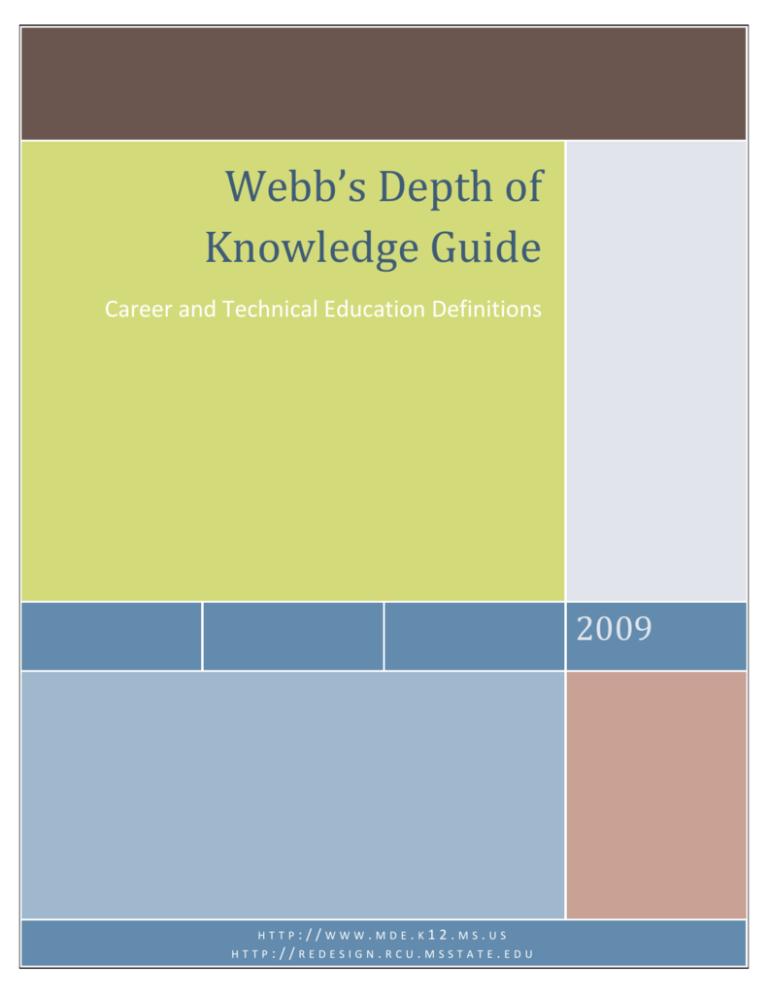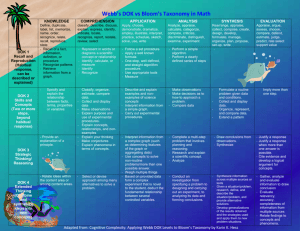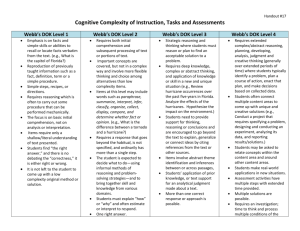Webb's Depth of Knowledge Guide
advertisement

Webb Webb’s Depth of Knowledge Guide Career and Technical Education Definitions 2009 1 ://WWW.MDE.K12.MS.US HTTP://REDESIGN.RCU.MSSTATE.EDU HTTP 2 TABLE OF CONTENTS Overview ........................................................................................................................................................................5 Level 1 – Recall & Reproduction ....................................................................................................................................7 Level 2 – Working with Skills & Concepts ......................................................................................................................9 Level 3 – Short-term Strategic Thinking ......................................................................................................................11 Level 4 – Extended Strategic Thinking .........................................................................................................................13 3 4 OVERVIEW Webb (1997) developed a process and criteria for systematically analyzing the alignment between standards and standardized assessments. Since then the process and criteria have demonstrated application to reviewing curricular alignment as well. This body of work offers the Depth of Knowledge (DOK) model employed to analyze the cognitive expectation demanded by standards, curricular activities and assessment tasks (Webb, 1997). The model is based upon the assumption that curricular elements may all be categorized based upon the cognitive demands required to produce an acceptable response. Each grouping of tasks reflects a different level of cognitive expectation, or depth of knowledge, required to complete the task. It should be noted that the term knowledge, as it is used here, is intended to broadly encompass all forms of knowledge (i.e. procedural, declarative, etc.). The following table reflects an adapted version of the model. DOK Level Title of Level 1 Recall and Reproduction 2 Skills and Concepts 3 Short-term Strategic Thinking 4 Extended Thinking DOK level are assigned to each course objective the following served as general guidelines for developers: The DOK level assigned should reflect the level of work students are most commonly required to perform in order for the response to be deemed acceptable. The DOK level should reflect the complexity of the cognitive processes demanded by the task outlined by the objective, rather than its difficulty. Ultimately the DOK level describes the kind of thinking required by a task, not whether or not the task is “difficult”. If there is a question regarding which of two levels a statement addresses, such as Level 1 or Level 2, or Level 2 or Level 3, it is appropriate to select the higher of the two levels. The DOK level should be assigned based upon the cognitive demands required by the central performance described in the objective. The objective’s central verb(s) alone is/are not sufficient information to assign a DOK level. Developers must also consider the complexity of the task and/or information, conventional levels of prior knowledge for students at the grade level, and the mental processes used to satisfy the requirements set forth in the objective. 5 6 LEVEL 1 – RECALL & REPRODUCTION Curricular elements that fall into this category involve basic tasks that require students to recall or reproduce knowledge and/or skills. The subject matter content at this particular level usually involves working with facts, terms and/or properties of objects. It may also involve use of simple procedures and/or formulas. There is little transformation or extended processing of the target knowledge required by the tasks that fall into this category. Key words that often denote this particular level include: list, identify and define. A student answering a Level 1 item either knows the answer or does not; that is, the answer does not need to be “figured out” or “solved.” POSSIBLE PRODUCTS Quiz Definition Fact Worksheet Test Label List Workbook Reproduction Vocabulary Quiz Recitation Example Collection Explanation Show and Tell Outline Blog Wiki Podcast Categorizing/Tagging Commenting Bulleting Highlighting Social networking ROLES TEACHER Directs Shows Questions Demonstrates Compares Examines STUDENT Tells Examines Evaluates Listens Contrasts Responds Remembers Memorizes Explains Restates Interprets Absorbs Recognizes Describes Translates Demonstrates POTENTIAL ACTIVITIES Develop a concept map showing a process or describing a topic. Make a timeline Write a list of keywords you know about… Make a chart showing… Recite a fact related to… Write in your own words… Cut out, or draw a picture that illustrates an event, process, or story. Report or present to the class. Make a cartoon strip showing the sequence of an event, process, or story. Write and perform… Write a brief outline and explain the event, process, or story. Write a summary report of the event Prepare a flow chart that illustrates the sequence of events. Paraphrase a chapter in the book Retell in your own words Outline the main points 7 Social bookmarking Searching Googling Recall, restate, remember, or recognize a fact, term, or property(Recognizing, listing, describing, identifying, retrieving, naming, locating, finding) Using basic calculation tasks involving only one step (i.e. addition, subtraction, etc), complete the following… Locate or retrieve information in verbatim form. Straight-forward recognition tasks related to identifying features, objects and/or steps that don’t vary greatly in form (i.e. recognizing features of basic tools). Writing tasks that involve applying a standard set of conventions and or criteria that should eventually be automated (i.e. using punctuation, spelling, etc) Basic measurement tasks that involve one step (i.e. using a ruler to measure length) Use this simple formula where at least one of the unknowns are provided to… Locating information in maps, charts, tables, graphs, and drawings 8 Level 2 – Working with Skills & Concepts Level 2 includes the engagement of some mental processing beyond recalling or reproducing a response. This level generally requires students to contrast or compare people, places, events and concepts; convert information from one form to another; classify or sort items into meaningful categories ; describe or explain issues and problems, patterns , cause and effect, significance or impact, relationships, points of view or processes. A Level 2 “describe or explain” would require students to go beyond a description or explanation of recalled information to describe or explain a result or “how” or “why.” The learner should make use of information in a context different from the one in which it was learned. Elements found in a curriculum that fall in this category involve working with or applying skills and/or concepts to tasks related to the field of study in a laboratory setting. The subject matter content at this particular level usually involves working with a set of principles, categories, heuristics, and protocols. At this level students are asked to transform/process target knowledge before responding. Example mental processes that often denote this particular level include: summarize, estimate, organize, classify, and infer. POSSIBLE PRODUCTS Photograph Illustration Simulation Sculpture Demonstration Presentation Interview Performance Dairy Journal Reverse-Engineering Cracking Codes Linking Mashing Relationship Mind Maps Blog Commenting Blog Reflecting Moderating Testing (Alpha/Beta) Validating ROLES TEACHER Shows Observes Organizes STUDENT Facilitates Evaluates Questions Solves problems Calculates Completes Constructs Demonstrates use of knowledge Compiles Illustrates POTENTIAL ACTIVITIES Classify a series of steps Construct a model to demonstrate how it looks or works Practices a play and perform in class Make a diorama to illustrate an event Write a diary/blog entry Make a scrapbook about the area of study Make a topographic map Make up puzzle or game about the topic Write an explanation about this topic for others Make a model… Routine application tasks (i.e. applying a simple set of rules or protocols to a laboratory situation the same way each time) Explaining the meaning of a concept and/or explaining how to perform a particular task Stating relationships among a number of concepts and or principles 9 More complex recognition tasks that involve recognizing concepts and processes that may vary in how they “appear” More complex calculation tasks (i.e. multi-step calculations such as standard deviation) Research projects and writing activities that involve locating, collecting, organizing and displaying information (i.e. writing a report with the purpose to inform; meeting all steps of the writing process) Measurement tasks that occur over a period of time and involve aggregating/organizing the data collected in to basic presentation forms such as a simple table or graph 10 LEVEL 3 – SHORT-TERM STRATEGIC THINKING Items falling into this category demand a short-term use of higher order thinking processes, such as analysis and evaluation, to solve real-world problems with predictable outcomes. Stating one’s reasoning is a key marker of tasks that fall into this particular category. The expectation established for tasks at this level tends to require coordination of knowledge and skill from multiple subject-matter areas to carry out processes and reach a solution in a project-based setting. Key processes that often denote this particular level include: analyze, explain and support with evidence, generalize, and create. POSSIBLE PRODUCTS Graph Spreadsheet Checklist Chart Outline Survey Database Mobile Abstract Report Debate Panel Report Evaluating Investigation Conclusion Program Film Animation Video cast Podcast Publishing Wiki-ing Uncovers Thinks deeply Questions Disputes Decides Argues Tests Calculates Compares Selects ROLES TEACHER Probes Observes Acts as a resource Organizes Clarifies Guides STUDENT Guides Evaluates Questions Dissects Accepts Discusses Debates Examines Judges Assesses Justifies POTENTIAL ACTIVITIES Use a Venn Diagram that shows how two topics are the same and different Design a questionnaire to gather information Survey classmates/industry members to find out what they think about a particular topics Make a flow chart to show the critical stages. Classify the actions of the characters in book Prepare a report about an area of study Conduct an investigation to produce information to support a view Write a letter to the editor after evaluation product Prepare and conduct a debate Prepare a list of criteria to judge Write a persuasive speech arguing for/against… Make a booklet about five rules you see as important. Convince others. Form a panel to discuss viewpoints on… Write a letter to… advertising on changes needed. Prepare a case to present your view about 11 Short-term tasks and projects placing a strong emphasis on transferring knowledge to solve predictable problems Explaining and/or working with abstract terms and concepts Recognition tasks when the environment observed is real-world and often contains extraneous information which must be sorted through Complex calculation problems presented that draw upon multiple processes Writing and or explaining tasks that require altering a message to “fit” an audience Creating graphs, tables and charts where students must reason through and organize the information with instructor prompts Identifying a research question and/or designing investigations to answer a question Tasks that involve proposing solutions or making predictions 12 Level 4 – Extended Strategic Thinking Curricular elements assigned to this level demand extended use of higher order thinking processes such as synthesis, reflection, assessment and adjustment of plans over time. Students are engaged in conducting investigations to solve real-world problems with unpredictable outcomes. Employing and sustaining strategic thinking processes over a longer period of time to solve the problem is a key feature of curricular objectives that are assigned to this level. Key strategic thinking processes that denote this particular level include: synthesize, reflect, conduct, and manage. POSSIBLE PRODUCTS Film Story Project Plan New Game Song Newspaper Media Product ROLES TEACHER Facilitates Reflects Evaluates STUDENT Extends Analyses Designs Takes risks Proposes Formulates Modifies Plans Creates POTENTIAL ACTIVITIES Applying information to solve ill-defined problems in novel situations Tasks that require a number of cognitive and physical skills in order to complete Writing and/or research tasks that involve formulating and testing hypotheses over time Tasks that require students to make multiple strategic and procedural decisions as they are presented with new information throughout the course of the event Tasks that require perspective taking and collaboration with a group of individuals Creating graphs, tables, and charts where students must reason through and organize the information without instructor prompts Writing tasks that have a strong emphasis on persuasion Devise a way to… Develop a menu for a new restaurant using a variety of healthy foods Sell an idea Write a jingle to advertise a new product Conduct an internship in industry where students are faced with real-world, unpredictable problems 13









